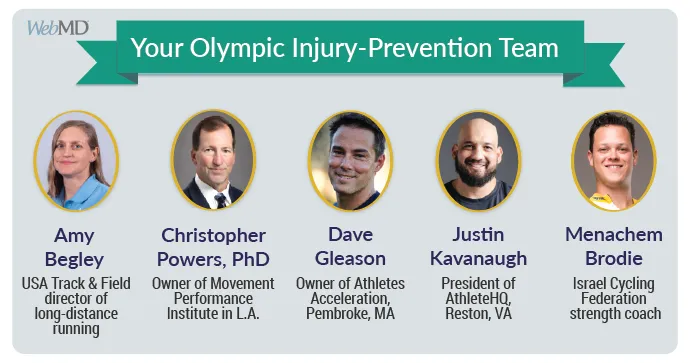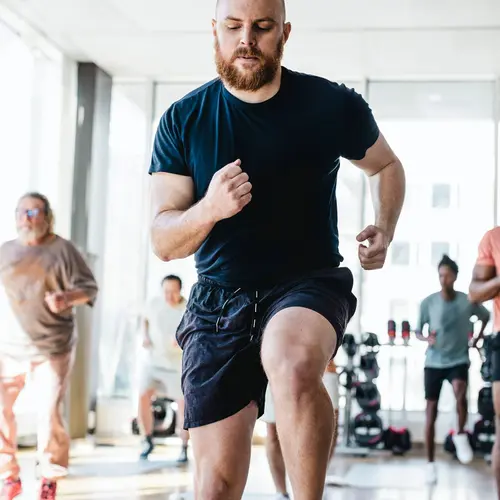June 26, 2024 -- Coaches who work with elite athletes face a constant challenge: To reach a new level, the athlete has to push their body beyond what it’s done before.
But if they push too hard, they risk an injury that could, at the very least, slow their progress. At worst, an injury could put them on the sidelines for months.

The challenge is especially acute for coaches who work with current or aspiring Olympic athletes. An ill-timed injury could mean the difference between competing this summer in Paris and hoping for better luck in 2028.
The five Olympic coaches we spoke to know a lot about injuries — one from personal experience, one from extensive scientific research, and all from many years of working with clients who include world champions, aspiring Olympians, serious recreational athletes, and fitness enthusiasts who just want to get through the day without nagging aches and pains.
What they’ve learned about preventing injuries in the best of the best can help you avoid them in your own fitness pursuits.

Lesson No. 1: Impatience leads to injuries
By the time Amy Begley retired from running, she had experienced the kind of success most athletes can only dream of: four-time state champion in high school, 15-time All American in college, multiple national championships as a pro.
She also competed in the 10,000 meters at the Beijing Olympics in 2008.
With those successes came a long list of injuries and constant, nagging pain. That’s not unusual for runners. As noted in a 2021 study, 1 in 4 runners are injured at any given time, and about half experience an injury each year.
“Most athletes, in most sports, there’s a pain level they’re willing to deal with to continue with their career or their season,” she said. “It’s their new normal. It’s what they’re used to.”
Begley is now director of long-distance running for USA Track & Field and 2024 U.S. Olympic coach for female cross-country and marathon runners.
Her top recommendation for runners: Be patient and progress slowly.
If you’re new to running, start with a walk-run program — 30 seconds of walking, 30 seconds of running, for example — and build up from there.
Even experienced runners should be cautious with each increase in their mileage, intensity, or frequency. “If you ask your legs to do more than they’re capable of doing, there’s going to be injury,” Begley said.
Taking periodic breaks during a long run may help prevent injury, according to University of Florida Health research presented to the International Olympic Committee last month. Walk for a minute or two and breathe until you've recovered — and also important, re-envision good running form as you start running again.
And don’t look at your running in isolation.
How much time do you spend on your feet at work or home? An ER nurse, for example, puts a lot of mileage on their knees and ankles before lacing up their running shoes. That sets them up for overuse injuries.
Do you do a lot of bending, lifting, and carrying? A parent might have fatigued or imbalanced core and hip muscles, which could set them up for lower-body injuries.
Where do you typically run? Begley grew up in rural Indiana, where the slope of the roads meant one foot constantly landed higher or lower than the other. That led to career-long problems with her Achilles tendons.
How much stress do you have in your life? How much sleep do you get?
“People don’t think about how their life affects their training,” Begley said. “You have to take everything into account.”
Lesson No. 2: Past injuries predict future injuries
As founder and owner of the Movement Performance Institute in Los Angeles, Christopher Powers, PhD, has worked with athletes and enthusiasts at every level — from Olympic gold medalists (in track and field, basketball, and beach volleyball) to recreational runners.
In every demographic, there’s one constant: The No. 1 predictor of an injury, whether we’re talking about the lower back, knees, ankles, or shoulders, is a previous history of that injury.
“What does that tell you?” Powers asked. “You didn’t address the underlying cause of the problem. From an injury standpoint, it’s treating the pain as opposed to the source of the pain.”
In most cases, he said, the issue “is inherent in the athlete’s biomechanics — how they’re moving, how they’re stressing certain joints and tendons and ligaments.”
That’s the focus of his research at the University of Southern California, where he’s a professor of biokinesiology and physical therapy. He’s published more than 200 studies, many of which have focused on the knee joints.
For example, he said, “A lot of knee injuries stem from poor hip strength.” Hip muscles control the femur (thigh bone), which is part of the the knee joint. “A lot of patients can’t activate the gluteal muscles,” which can result in knee valgus — the joint rolling inward when you walk, run, or jump. “That puts a lot of stress on the knee.”
In those cases, the solution might be glute-activation exercises.
But for others, the solution will be very different.
“Not all knee pain comes from the hip,” Powers said. “Some patients have calf weakness.”
The only way to know for sure is to get evaluated by a professional — someone who can analyze your biomechanics, identify the cause of the problem, and help you develop a program to address it. He said it’s worth the time and expense if you really want to remain injury-free because imbalances are not something most people can feel or spot in themselves. "There’s no general fix for any of this stuff.”
But there is one thing you can bet on: If you don’t find and address the cause of a past problem — whether it’s shin splints or shoulder pain— there’s a very good chance it’s going to become a future problem.
Lesson No. 3: Injuries find the places you’ve neglected
Strength coach Menachem Brodie sees an odd problem with some of the older and more experienced cyclists he works with: They struggle to raise their arms overhead.
All those hours spent hunched over handlebars have severely truncated their shoulder mobility.
Why does it matter if an athlete can do a movement that isn’t part of their sport?
“You need shoulders that move well in order to breathe well,” he said. Breathing well releases tension in the diaphragm, which allows the rest of your body to move well.
And moving well is the key to staying healthy while training for high performance — or just living life and aging well.
That’s why Brodie, who works as a strength coach for the Israel Cycling Federation and Olympic triathlete Shachar Sagiv (who’ll be heading to Paris for his second Olympics), has his athletes begin each training session with an exercise like crocodile breathing. (Lying face down with a folded towel or pad between the bottom of the ribcage and the hips to promote better posture and more efficient breathing.)
From there they work on mobility, followed by exercises for the core and trunk muscles.
None of those drills apply directly to the athletes’ events. And that’s exactly why they do them.
“To prevent injuries, you need to train the things you don’t [develop] in your sport,” he said.
Whatever you’ve neglected is almost certain to be your weakest link.
Lesson No. 4: A tight body will soon be an injured body
Justin Kavanaugh coaches some of the fastest people in the world, including U.S. Paralympic sprinter Nick Mayhugh, Yohan Blake from Jamaica, and Jason Rogers from St. Kitts and Nevis.
Their speed requires extraordinary levels of muscle tension. Muscle tension leads to tight, compressed joints. “A compressed joint is going to reduce the amount of force you can produce,” Kavanaugh said. “It’s also going to cause some sort of injury or pain long term.”
To resolve the problem, his athletes do a lot of flexibility work, most of which is static stretching.
He encourages his clients at Athlete HQ, his facility in Reston, VA, to move every joint through its full range of motion every day.
“It’s a daily audit of how your body and joints are feeling,” Kavanaugh said. If something isn’t moving as well as it should, you can address it right away.
Even if you can’t correct it, you can at least avoid turning a small problem into a bigger one.
Lesson No. 5: Coordinated movements are safe movements
Dave Gleason, like Kavanaugh, coaches a mix of athletes and recreationally active adults, primarily adolescent soccer players at Athletes Acceleration, his facility in Pembroke, MA. The most advanced players are in the Olympic Development Program, with the goal of eventually making the U.S. national team.
One of his biggest challenges: keeping the kids from burning out and breaking down before they reach their full potential.
“Kids haven’t changed, but the environment has,” Gleason said. “From a neurological and physical standpoint, they’re extremely fatigued.”
They’re overscheduled and overworked, he said, with all the social pressures of adolescence, at a time when their bodies are changing inside and out. “Their bones are growing faster than their ligaments and tendons and muscles,” he said.
That helps explain why kids from 10 to 14 account for most sports injuries in the U.S. And kids who specialize in a single sport are 37% more likely to get injured than their counterparts who play more than one.
That stress of constant grinding means “they lose flexibility and mobility in their joints,” Gleason said. “So they become tighter, less fluid, less proficient athletes on the field.”
Gleason emphasizes play — moving, anticipating, reacting. Predicting where the ball will go and getting there.
“All the things you would teach in a gym class to a 6-year-old, you still need to help these young athletes enhance,” he said.
The drills help restore fluidity to their movements while also aiding recovery from games and practice.
Gleason said the same tactics work for adults. After all, adults deal with stress at work and home at a time when their bodies are changing in often unwelcome ways. Anecdotally, Gleason said, an emphasis on mobility and coordination helps reduce their injury rates.
So how do you apply those concepts to your own life and exercise routine?
“Get outside and play, if you have the opportunity,” Gleason advises. Try pickleball, if you haven’t already. Shoot baskets. Hit a bucket of balls at the driving range. Go bowling. Anything that involves coordinated movement will do the trick.
Injuries are the ultimate wake-up call. If there’s one overarching lesson to take away from these Olympic coaches, it’s this: You can’t avoid every injury, but you can certainly learn from them. Whatever the cause, your body is telling you that something is wrong.
Dealing with it now “can save you time, frustration, and money over the long term,” said former Olympic runner Amy Begley.
“I’ve had more MRIs and X-rays than I could count,” she said. A typical day for her might begin with her body so sore and stiff she walked with a limp.
A few months after she retired, she noticed she no longer woke up in pain. “I was like, ‘Oh, this is nice!’"
